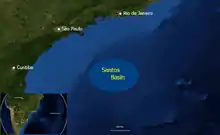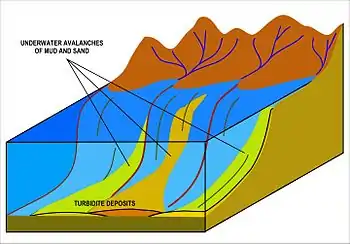Juréia Formation
The Juréia Formation (Portuguese: Formacão Juréia) is a geological formation of the Santos Basin offshore of the Brazilian states of Rio de Janeiro, São Paulo, Paraná and Santa Catarina. The predominantly shale with interbedded siltstones and fine sandstones formation dates to the Late Cretaceous period; Santonian-Maastrichtian epochs and has a maximum thickness of 2,000 metres (6,600 ft). The formation is a reservoir rock of the Merluza Field, the first discovery in the Santos Basin.
| Juréia Formation Stratigraphic range: Santonian-Maastrichtian ~86–66 Ma | |
|---|---|
| Type | Geological formation |
| Unit of | Frade Group |
| Underlies | Marambaia Formation |
| Overlies | Itanhaém Formation |
| Thickness | up to 2,000 m (6,600 ft) |
| Lithology | |
| Primary | Shale |
| Other | Siltstone, sandstone |
| Location | |
| Coordinates | 26°6′S 43°43′W |
| Region | Santos Basin, South Atlantic |
| Country | |
| Type section | |
| Named for | Juréia-Itatins Ecological Station |
 Location of the Santos Basin | |
Etymology
The formation is named after the Juréia-Itatins Ecological Station, São Paulo.
Description

The Juréia Formation is 952 to 2,000 metres (3,123 to 6,562 ft) thick,[1] and includes a succession of clastics between the coarse facies of the Santos Formation in the western proximal part and the fine-grained clastics of the Itajai-Açu Formation in the eastern distal part of the Santos Basin. The formation is characterized by dark grey to greenish and brown shales, dark grey siltstones, fine-very fine sandstones and light ochre calcisilts. The depositional environment is thought to be of a marine platform setting as pro-delta facies on the shelf edge.[2] The age based on palynomorphs and calcareous nanofossils is Late Cretaceous (Santonian-Maastrichtian).[3] Two new ostracod species were identified in the drilling cuttings of wells drilled into the Santonian-Campanian section, ?Afrocytheridea cretacea and Pelecocythere dinglei.[4]
The formation is the reservoir rock of the Merluza Field, the first discovery in 1979 of the Santos Basin.[5][6]
See also
References
- Kiang Chang et al., 2008, p.32
- Contreras, 2011, p.104
- Clemente, 2013, p.23
- Piovesan, 2010, p.177
- "Santos Basin Fields". Archived from the original on 2017-09-07. Retrieved 2017-09-07.
- Vieira, 2007, p.19
Bibliography
- Clemente, Pilar. 2013. Petroleum geology of the Campos and Santos basins, Lower Cretaceous Brazilian sector of the South Atlantic margin, 1–33. Danmarks Tekniske Universitet. Accessed 2017-09-04.
- Contreras, Jorham. 2011. Seismo-stratigraphy and numerical basin modeling of the southern Brazilian continental margin (Campos, Santos, and Pelotas basins) (PhD thesis), 1–171. Ruprecht-Karls-Universität Heidelberg. Accessed 2017-09-04.
- Kiang Chang, Hung; Mario Luis Assine; Fernando Santos Corrêa; Julio Setsuo Tinen; Alexandre Campane Vidal, and Luzia Koike. 2008. Sistemas petrolíferos e modelos de acumulação de hidrocarbonetos na Bacia de Santos. Revista Brasileira de Geociências 38. 29–46. Accessed 2017-09-04.
- Piovesan, Enelise Katia; Cristianini Trescastro Bergue, and Gerson Fauth. 2010. New ostracode species from the Upper Cretaceous of the Santos Basin, Brazil. Revista Brasileira de Paleontologia 13. 175–180. Accessed 2017-09-04.
- Vieira, Juliana. 2007. Brazil Round 9 - Santos Basin, 1–73. ANP. Accessed 2017-09-04.